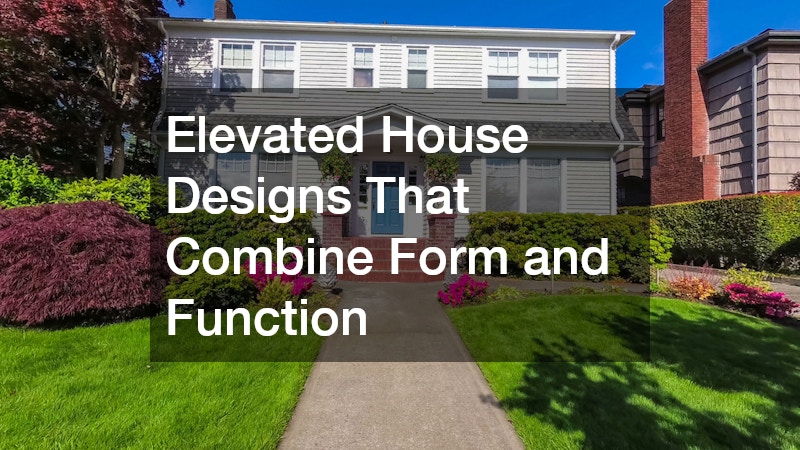When you think of a home that’s truly remarkable, you might picture striking architecture, breathtaking views, and clever use of space. Elevated house designs bring all of these elements together in a way that is both beautiful and practical. These designs are not just about raising a house above the ground; they’re about raising the standard of living as well.
Elevated house designs have evolved over time from purely functional solutions to environmental or safety concerns into true works of art that enhance a home’s livability and sustainability. Whether situated on a steep hillside, perched above floodplains, or designed to capture optimal sunlight and air circulation, these homes demonstrate how architecture can harmonize with nature instead of working against it.
This article explores how elevated house designs blend form and function seamlessly, providing homeowners with smarter, more resilient living spaces. We’ll also look at their history, benefits, materials, planning strategies, costs, sustainability, challenges, and even how to integrate smart technologies. By the end, you’ll understand why elevated house designs aren’t just a trend — they’re a thoughtful response to modern living needs. Let’s step up and explore what makes them so extraordinary.
What Are Elevated House Designs?
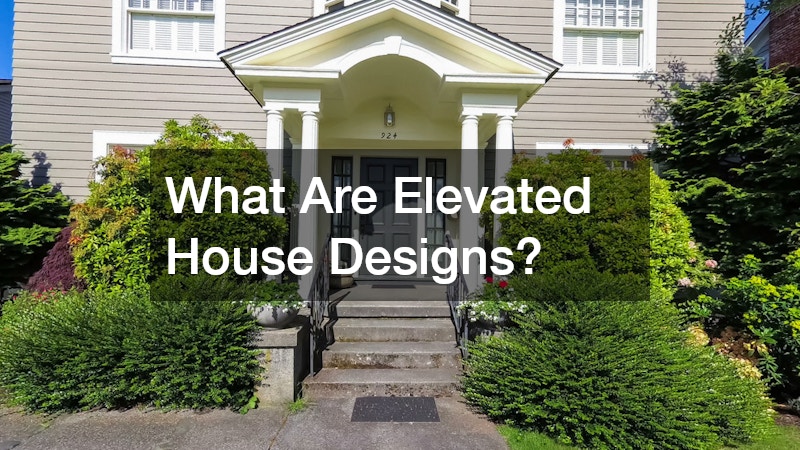
Definition And Overview
Elevated house designs refer to homes that are built on stilts, piers, columns, or raised foundations, creating a distinct separation between the living area and the ground. This approach is often used to protect against flooding, improve ventilation, or make use of a sloped site that would otherwise go unused. It’s also a smart way to avoid damage from pests or shifting soils while providing a more flexible space underneath. A contractor can help evaluate the right height and materials for an elevated foundation to meet your specific needs and ensure longevity.
Historical Context
Historically, elevated houses have been a necessity in regions prone to flooding or wildlife intrusion. In many parts of Southeast Asia, homes were traditionally built on stilts to avoid water damage and improve airflow in hot climates. Similar strategies can be seen in early American coastal homes, where raised foundations helped mitigate storm surges. These designs allowed easy maintenance with waterproofing services and provided access for local pest control service treatments, extending the home’s life.
Modern Interpretations
Today, elevated house designs combine these time-tested principles with modern materials, energy-efficient technologies, and aesthetic sophistication. They often feature large windows from the best window manufacturers, decks that require regular home deck inspection, and foundations reinforced by experienced concrete companies. Elevated homes can now also integrate paving service pathways and smart technology, creating homes that are not only safer and more sustainable but also highly functional and beautiful.
Why Choose Elevated House Designs?
Benefits Of Elevation
One of the main reasons homeowners choose elevated house designs is protection — from floods, pests, and shifting soils. Homes elevated properly also allow local pest control services to access and treat the understructure, improving long-term health and safety. Beyond that, raised homes can reduce dampness and mold issues, saving on repairs and maintenance costs over time. Working with a skilled contractor ensures the elevation is structurally sound and optimized for your specific property.
Aesthetic Appeal
Beyond functionality, elevated houses have an undeniable visual appeal. They offer better views, dramatic profiles, and a unique sense of space. Complemented by expert door repair and high-quality replacement window services, these homes stand out in any neighborhood. Their distinctive design often increases curb appeal and property value, making them a worthwhile investment. Even the surrounding landscaping can be enhanced with paving contractors who create walkways and patios that complement the raised structure.
Case Studies: Success Stories
Several coastal communities have embraced elevated designs after devastating storms. These homes not only survived natural disasters but also became architectural landmarks. In urban settings, elevated homes create private sanctuaries above the hustle and bustle of city life. Many homeowners also take advantage of the extra space below for outdoor kitchens, storage, or parking, with help from paving service experts and concrete companies to make the area functional and visually appealing.
How Do Elevated House Designs Improve Functionality?
Space Utilization
The space below an elevated home can be used for parking, storage, or outdoor living areas. With input from paving contractors and a skilled contractor, homeowners can transform this area into usable square footage. The addition of pathways and concrete pads by concrete companies or paving service teams ensures this space remains practical and attractive. Regular home deck inspection ensures the upper living area remains structurally safe while the lower area remains functional.
Climate Adaptability
Elevated designs work with the natural elements, promoting airflow to cool the house and minimizing moisture damage through waterproofing services. This adaptability extends the life of the building and improves comfort. In hot or humid regions, the improved ventilation can drastically reduce energy costs and help maintain indoor air quality, while in flood-prone zones, the elevation helps avoid costly repairs.
Enhanced Views And Natural Light
Because they sit higher, these homes often have unobstructed views and better access to sunlight. Choosing windows from the best window manufacturers and ensuring professional replacement window services can maximize these benefits. Strategically placing windows and decks allows homeowners to enjoy panoramic vistas, increased natural light, and a stronger connection to the surrounding landscape, all of which enhance the living experience.
What Materials Are Best For Elevated Designs?
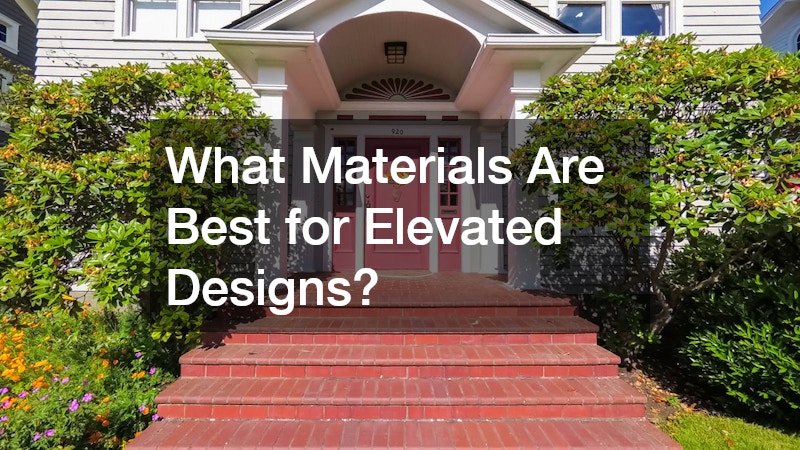
Sustainable Options
For environmentally conscious homeowners, elevated designs can incorporate reclaimed wood, recycled steel, and energy-efficient glass. Even elements like the deck and foundation can benefit from a contractor using sustainable materials and techniques. These choices not only reduce environmental impact but also often result in long-term savings due to increased durability and lower maintenance costs.
Durability Considerations
Durability is paramount in elevated homes. Materials should resist moisture, pests, and wind. Hiring concrete companies and paving service professionals ensures your foundation and pathways are built to last. Homes in harsh climates can benefit from weather-resistant siding, treated wood, and reinforced glass from the best window manufacturers, ensuring the structure holds up for decades.
Innovative Materials
Advancements in materials science have introduced innovative solutions like fiber-reinforced concrete, weather-resistant composites for decks, and waterproof coatings that extend the lifespan of key structural components. Even finishing touches such as replacement window services and door repair now feature more durable, eco-friendly products. Working with a knowledgeable contractor who understands how to blend these materials ensures that your elevated home performs beautifully while minimizing long-term upkeep.
How To Plan And Design An Elevated House?
Site Analysis
Every elevated house design starts with understanding the site. Factors such as soil type, slope, and drainage dictate how high the house needs to be and which materials are appropriate. Local contractors and waterproofing services can help assess site conditions.
Architectural Style Choices
From modern minimalism to traditional charm, elevated designs can adapt to virtually any style. Engaging a knowledgeable contractor ensures your vision aligns with the practical demands of the site.
Integration With The Environment
A good elevated house design feels like a natural extension of its environment. Incorporating native plants, sustainable paving services, and locally sourced materials helps the home blend in while remaining functional.
What Are The Cost Considerations For Elevated Designs?
Budgeting For Materials
Elevated homes typically cost more than standard homes because of additional structural requirements and materials. Choosing affordable yet reliable materials from the best window manufacturers and concrete companies helps manage costs.
Long-Term Value
While the initial investment might be higher, the long-term value of elevated house designs is significant. These homes often experience fewer flood-related damages, reducing insurance premiums and maintenance costs over time.
Financing Options
Many lenders offer specialized financing for elevated designs, especially in flood-prone areas. Working with a contractor who understands these programs can make financing smoother.
How Do Elevated House Designs Impact Sustainability?
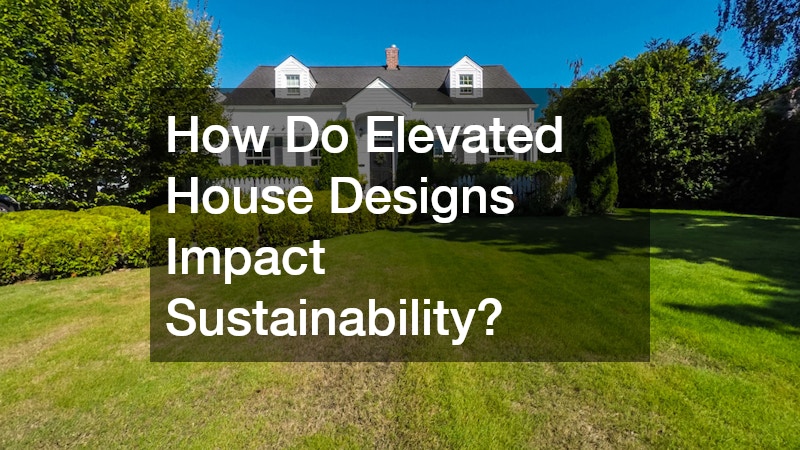
Energy Efficiency
Elevated homes are naturally more energy efficient thanks to improved airflow, which reduces cooling needs. High-performance doors and windows, installed by experienced door repair and replacement window services, further enhance efficiency.
Reduced Footprint
By minimizing disturbance to the land and using compact, raised foundations, these homes often have a smaller environmental footprint. Paving contractors and waterproofing services can recommend eco-friendly options for exterior surfaces as well.
Ecosystem Considerations
Elevated designs can preserve local ecosystems by allowing water and wildlife to move freely underneath. This consideration supports biodiversity while still providing a functional living space.
What Are The Challenges Of Elevated House Designs?
Engineering And Structural Integrity
Building an elevated house requires precise engineering to ensure structural integrity. Experienced contractors and concrete companies play a crucial role in ensuring your home stands strong against environmental stresses.
Zoning And Regulatory Challenges
Not all areas permit elevated designs, so it’s essential to consult local regulations. A knowledgeable contractor can navigate permits, zoning laws, and inspections.
Adaptation To Local Conditions
Designs must consider local weather, pests, and soil. For example, a local pest control service provider might need to treat the crawl space more frequently to prevent infestations, and waterproofing services can mitigate heavy rainfall impacts.
How To Incorporate Smart Technology In Elevated House Designs?
Automation Systems
Home automation makes elevated homes even more convenient. Lighting, heating, and cooling can all be managed remotely, reducing energy waste and enhancing comfort. Modern elevated homes often incorporate smart lighting that adapts to daylight, motorized shades, and climate control systems that keep the interior comfortable in any weather. These technologies are especially useful in elevated homes where airflow and natural light already play an important role, allowing homeowners to fine-tune conditions room by room.
Energy Management Tools
Smart thermostats, solar panels, and efficient appliances can cut energy costs significantly. Consulting a contractor who understands these technologies is invaluable for integrating them seamlessly into the home’s design. Many homeowners also opt for energy monitoring tools that track consumption in real time, helping them make smarter choices and reduce utility bills.
Security Integration
Because elevated homes are often more visible, incorporating smart security systems — from cameras to automated locks — is a wise investment. Reliable door repair and modern window hardware also contribute to safety.
What Are Some Inspiring Examples Of Elevated House Designs?
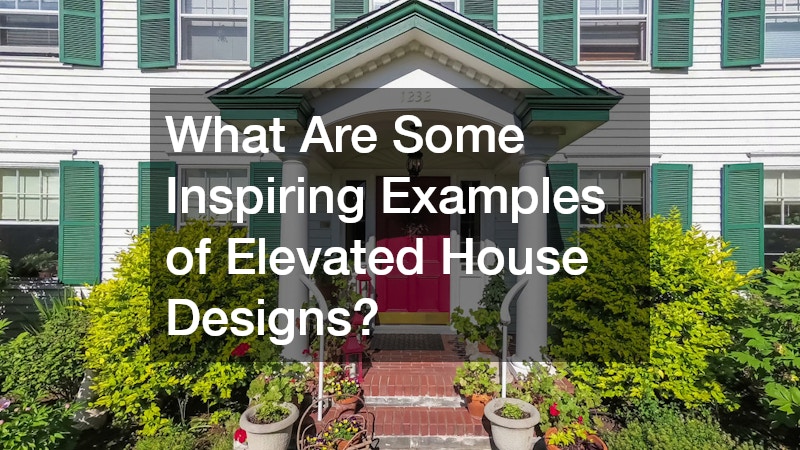
Iconic Global Designs
From the treehouses of Costa Rica to the flood-resistant homes of the Netherlands, elevated designs around the world inspire creativity and resilience. These iconic global designs often make ingenious use of limited space while respecting the surrounding ecosystem, proving that elevated house designs can be both beautiful and practical. They showcase how homes can sit lightly on the land while still offering exceptional comfort and durability.
Innovative Local Projects
In the U.S., many coastal areas have embraced elevated homes as a response to climate change, blending traditional forms with modern amenities like waterproofing services and high-end materials from the best window manufacturers.
Future Trends In Design
We can expect more integration of sustainable materials, smart technologies, and creative use of space as homeowners continue to seek elevated house designs that reflect their lifestyle and environmental values. Future trends include modular construction, self-sustaining energy systems, and even more collaboration between architects, contractors, and paving contractors to create elevated homes that are not only resilient but also stunning architectural statements.
Conclusion
Elevated house designs offer more than just an architectural statement — they provide a lifestyle that harmonizes safety, sustainability, and beauty. These homes exemplify how thoughtful design can meet the demands of modern living while respecting the environment and local conditions. From maximizing views and airflow to protecting against floods and pests, elevated house designs showcase the remarkable potential of creative problem-solving.
Throughout this journey, we’ve seen how elevated homes can integrate materials chosen for durability and sustainability, how smart technologies can enhance daily living, and how careful planning and execution can overcome regulatory or engineering challenges. With guidance from experienced contractors, concrete companies, paving contractors, and services such as home deck inspection and waterproofing, homeowners can create a space that truly elevates their quality of life.
Whether you’re inspired by iconic global designs or want to craft something entirely your own, elevated house designs stand as a testament to what’s possible when form and function come together. As you plan your dream home, consider the myriad benefits and innovations that elevated designs offer — and take your living experience to new heights.
